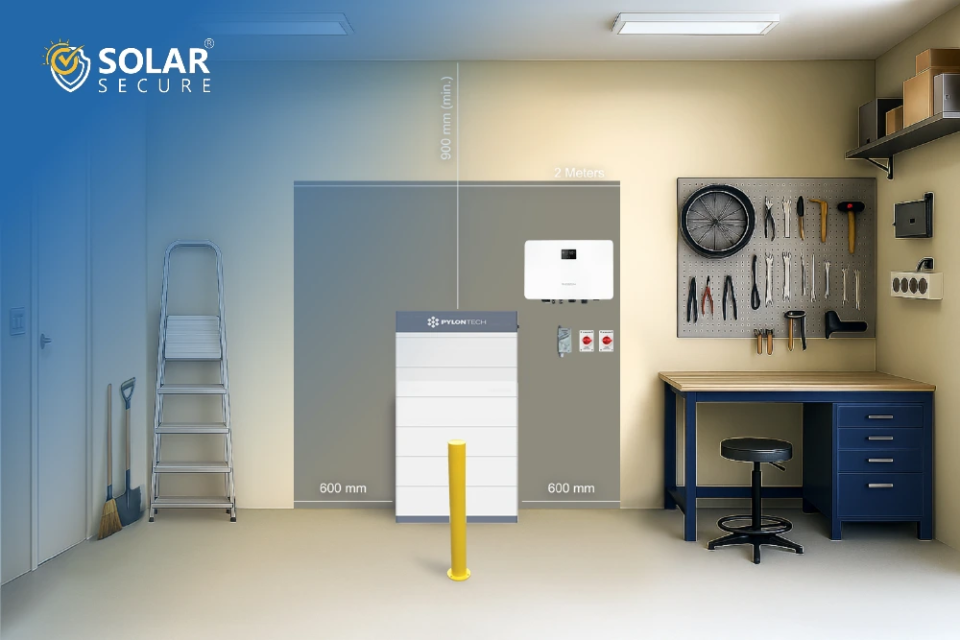Choosing the right location for your solar battery is crucial not only for safety but also for optimising the performance and lifespan of the system. Where solar energy adoption is on the rise, finding the best spot to install your solar battery ensures you get the most out of your investment. This guide will explore the factors to consider when selecting the ideal location for your solar battery, highlighting both indoor and outdoor options, and addressing common concerns.
Compliance with Battery Installation Standards
When installing a solar battery, location choice isn’t just about convenience, it’s a regulatory issue. Installers and homeowners must comply with the current standard for battery systems in Australia. This guideline outlines acceptable zones, restricted areas, and minimum clearances from habitable spaces, windows, and ignition sources.
Additionally, the Clean Energy Council (CEC) provides technical guidelines that align with most manufacturer warranties. If you ignore these, you risk not only voiding your warranty but also failing your safety inspection.
Key Requirements Include:
- No installation in habitable rooms (bedrooms, kitchens, etc.)
- Minimum 600mm clearance around the battery system
- Protection from water, direct sun exposure, and fire hazards
- Ventilation to manage thermal discharge and gases
- Compliance with manufacturer-specific mounting and airflow instructions
Where can solar batteries legally be installed?
Solar batteries can be installed in garages, utility rooms, or shaded outdoor walls, provided the space is non-habitable and meets clearance and ventilation requirements. Habitable rooms, small enclosed spaces, or areas without airflow are generally prohibited under and CEC rules. This ensures safety, system longevity, and regulatory compliance.
Can I install a solar battery indoors?
Yes, solar batteries can be installed indoors, if the area is well-ventilated and free from high humidity or heat. Garages, utility rooms, or large closets are often suitable locations. Make sure the battery is not installed in habitable rooms like bedrooms or kitchens and always maintain sufficient clearance around the unit for safety.
Ideal Indoor Locations for Solar Battery Installation
Indoor installations can offer an extra layer of protection for your solar battery, provided the area complies with safety standards. When looking for the perfect spot inside your home or garage, it’s essential to consider both the environmental and technical factors that can influence the battery’s performance and safety.
Recommended Indoor Locations:
- Garage or Utility Room: One of the most popular indoor locations for solar batteries is the garage. These spaces are typically well-ventilated, have ample space for clearances, and are far from direct sunlight, which is crucial for battery longevity. Additionally, garages are often already equipped with the necessary electrical wiring and safety protocols.
- Basements (if dry and ventilated): In areas like Sydney, basements can be ideal if they’re dry, cool, and equipped with proper ventilation. However, ensure they are not prone to flooding, which could pose a serious risk to the battery’s safety and performance.
- Utility Closets or Unused Rooms: Some homeowners opt for installing their solar batteries in unused rooms or utility closets, where the space is kept at a relatively stable temperature and is away from living areas. Ensure that the closet offers sufficient air circulation to prevent overheating.
Considerations:
- Ventilation is Key: Even indoors, proper ventilation is essential for maintaining your battery’s temperature and preventing the buildup of potentially harmful gases.
- Accessibility for Maintenance: Ensure that the installation area remains accessible for future maintenance or battery replacement, as these tasks may require professional servicing.
Key Tip: Avoid areas with high humidity, such as bathrooms or damp basements, as excess moisture can significantly reduce the battery’s lifespan and efficiency.
Can a solar battery be installed outside?
Yes, a solar battery can be installed outside, but it must be placed in a shaded location and housed in a weatherproof enclosure to protect it from rain, direct sunlight, and extreme temperatures. Proper ventilation and clearance must also be maintained to ensure optimal performance and safety.
Outdoor Locations for Solar Battery Installation
For many homeowners, outdoor installations may seem like a more convenient option, especially if space indoors is limited. However, when installing a solar battery outside, there are additional considerations to ensure both safety and optimal performance. While outdoor installations can be beneficial in certain circumstances, it’s essential to protect the battery from the elements and ensure it complies with all relevant safety standards.
Recommended Outdoor Locations:
- Shaded Areas: When choosing an outdoor location for your solar battery, it’s crucial to pick a shaded area to avoid the battery being exposed to direct sunlight for extended periods. Direct sunlight can cause overheating, which reduces the battery’s efficiency and lifespan. A well-shaded spot will help keep the battery cool.
- Walls of the House or Shed: Installing your solar battery against a wall of your home or shed can provide shelter from the elements while still offering the benefits of an outdoor setup. Make sure the area is sheltered from rain and extreme weather conditions, with sufficient airflow to avoid heat buildup.
- Outdoor Enclosures: If placing the battery outdoors, it’s often best to house it in a weatherproof enclosure. This protects the battery from rain, dust, and other environmental factors while still allowing for airflow and proper ventilation. These enclosures should be made from durable, UV-resistant materials.
Considerations:
- Protection from the Elements: Outdoor environments expose solar batteries to various weather conditions, including rain, snow, and extreme heat. Installing the battery in a protective enclosure will help shield it from water ingress and damage caused by the weather.
- Temperature Control: Excessive heat can damage solar batteries, so it’s important to avoid direct exposure to the sun. Choose a location that remains cool and shaded throughout the day to help manage the internal temperature of the battery.
- Clearances and Accessibility: As with indoor installations, outdoor setups must meet minimum clearance requirements. Ensure the battery remains accessible for maintenance or servicing, and make sure no physical obstructions, like overgrown plants, block ventilation.
Key Tip: Installing your solar battery in an outdoor, shaded location can help reduce the risk of heat buildup, but always use a protective enclosure to avoid weather damage.
No-Install Areas: Battery Placement Restrictions You Should Know
While installing batteries indoors is often the recommended choice for safety and durability, there are instances where this option might not be feasible. According to the AS/NZS 5139:2019 standard, certain locations are off-limits for battery installation due to safety concerns. In this segment, we'll explore these restricted areas and gain an understanding of why these limitations exist.
Restricted Installation Areas
AS/NZS 5139:2019 sets forth clear guidelines on areas where battery installation is prohibited. These regulations aim to minimize risks associated with electrical systems and to ensure the safety of occupants and the overall structural integrity of the building. The restricted areas include:
Switchboards (AS/NZS 3000): Batteries cannot be installed within the vicinity of switchboards, as outlined in AS/NZS 3000, which covers wiring rules and electrical installations.
Within 600mm of any exit: This is a precautionary measure to facilitate safe evacuation in case of emergencies. Placing batteries near exits could hinder the flow of occupants during evacuations.
Within 600mm of any vertical side of a window, or any building ventilation, opening into a habitable room: The standard emphasizes maintaining safe distances from windows and building ventilation openings to prevent potential hazards, such as fire spreading.
Within 600mm of any appliance: Keeping batteries away from appliances reduces the risk of heat accumulation and potential malfunctions due to the heat generated.
Within 900mm below any of the above: A minimum vertical distance of 900mm is maintained between the battery and the restricted areas listed above.
Ceiling spaces: Batteries are not to be installed in ceiling spaces to avoid potential fire hazards and to maintain clear access for maintenance.
Wall cavities: Placing batteries in wall cavities is prohibited due to safety concerns and potential damage to structural components.
On roofs (except where specifically deemed suitable): While some roof installations might be acceptable, batteries are generally not recommended to be placed on roofs due to potential exposure to extreme weather conditions.
Under floors of habitable rooms: Batteries should not be placed under the floors of habitable rooms to ensure safety and avoid possible damage to the structure.
Under stairways: Installing batteries under stairways is prohibited to prevent hindrance to safe movement and to uphold structural integrity.
Under access walkways: Battery installation under access walkways could compromise safe movement and evacuation routes.
In an evacuation route or escape route: Placing batteries in evacuation or escape routes obstruct safe passage during emergencies.
Key Tip: Always avoid installing your solar battery in areas that lack adequate ventilation or are prone to moisture and high temperatures. These environmental factors can significantly reduce the battery’s lifespan and lead to dangerous safety hazards.
Why is Professional Installation Essential?
DIY battery installation is illegal in Australia and risks electrical hazards, warranty voids, and AS/NZS 5139 non-compliance. Professional installers bring expertise and ensure safe wiring, proper placement, and grid integration. At Solar Secure, we use accredited experts and top-tier brands to deliver reliable solar battery systems tailored for Australian homes.
Conclusion
Selecting the ideal location for your solar battery is essential for both safety and efficiency. Whether you choose an indoor or outdoor setup, ensuring that the installation complies with local regulations, such as the standards and the Clean Energy Council guidelines, is key to maintaining the performance and longevity of your system.
By avoiding areas prone to moisture, excessive heat, or limited ventilation, and ensuring your installation complies with local building codes, you’ll be able to enjoy reliable, cost-effective energy storage for years to come. At Solar Secure, we are dedicated to providing expert advice and assistance to ensure your battery installation is seamless, efficient, and safe. Don't hesitate to reach out to us for more information or assistance with your battery installation. Together, we can power your home with clean, renewable energy while keeping your system running at its best.





